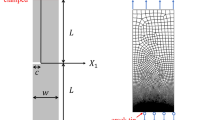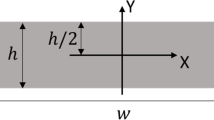Abstract
This work is concerned with the analysis of rapid crack propagation (RCP) in Polymethylmethacrylate (PMMA), Polycarbonate (PC) and two-layer PMMA/PC systems. Remarkably constant crack speeds were observed, and higher crack speeds corresponded to the higher preloads. Uniform fracture surfaces were associated with these constant speed RCPs. An indirect method was used to characterise dynamic fracture properties of the materials. The method relies on the recorded crack length histories and boundary conditions which are incorporated in a dynamic Finite Element (FE) code to generate the crack resistance (G ID). The numerical simulation of the constant speed RCPs generated highly scattered G ID data. Very large variations of the computed G ID with the crack length did not correspond to fracture surface appearances. Geometry dependent and multivalued crack resistance results with respect to the crack speed cast doubt on the uniqueness of G ID. In this work, attempts were made to overcome these difficulties by exploring the concept that the anomalies arise from large local strains around the rapidly moving crack tip, resulting in the crack ‘seeing’ a low local modulus. It is demonstrated that the critical source of error on the analysis of RCP, is the improper linear elastic representation of the material behaviour around the propagating crack tip. Since the parameters describing the behaviour of the materials near the propagating crack tip were unknown, local non-linear effects were approximated by a local low modulus strip along the prospective crack path. The choice of the local modulus was justified by measurements of the strain histories along the crack path during RCP. The local strip low modulus model generated a larger amount of the kinetic energy in the sample and the crack resistance was reduced compared to results from the single constant modulus approach. Most importantly, G ID data were nearly independent of the crack length, crack speed and the specimen size. This local modulus concept was also successfully applied to the analysis of RCP in the duplex specimen configuration.
Similar content being viewed by others
References
G.C. Sih (ed.), Dynamic Crack Propagation, Noordhoff (1973).
L.B. Freund, Dynamic Fracture Mechanics, Cambridge University Press (1990).
M.F. Kanninen, C.P. Leung and P.E. O'Donoghue, Plastic Pipes VIII, D1/8 (1992).
P.S. Leevers, G. Venizelos and A. Ivankovic, Plastic Pipes VIII, D1/7 (1992).
B.K. Broberg, in Dynamic Crack Propagation, G.C. Sih (ed.), Noordhoff (1973) 461.
W.G. Knauss, in Sixth International Conference on Fracture, New Delhi, Vol. 1 (1984) 625.
J.G. Williams and A. Ivankovic, International Journal of Fracture 51 (1991) 319.
A. Ivankovic, Ph.D. thesis, University of London, Imperial College (1991).
A.S. Kobayashi, in International Conference on Structural Impact and Crashworthiness, Imperial College, London (1984).
A.S. Kobayashi et al., International Journal of Fracture 30 (1986) 275.
J.W. Dally, W.L. Fourney and G.R. Irwin, International Journal of Fracture 27 (1985) 159.
A.J. Rosakis and A.T. Zehnder, International Journal of Fracture 27 (1985) 169.
A.J. Rosakis and K. Ravi-Chandar, International Journal of Solids and Structures 22 (1986) 121.
M.F. Kanninen, International Journal of Fracture 27 (1985) 299.
B. Crouch, Ph.D. thesis, University of London, Imperial College (1986).
J.F. Kalthoff, in Proceedings of the Workshop on Dynamic Fracture, W.G. Knauss and K. Ravi-Chandar (eds.), California Institute of Technology (1983) 11.
D.A. Shockey et al., Experimental Mechanics 23 (1983) 140.
K. Ravi-Chandar and W.G. Knauss, International Journal of Fracture 25 (1984) 247.
K. Ravi-Chandar and W.G. Knauss, International Journal of Fracture 26 (1984) 141.
W.G. Knauss and K. Ravi-Chandar, International Journal of Fracture 27 (1985) 127.
K. Takahashi and K. Arakawa, in International Symposium on Toughness, Fracture and Fatigue of Polymers and Composites, Yamagata University, Japan (1990).
J.G. Williams, International Journal of Fracture 33 (1987) 47.
A.J. Rosakis et al., in Dynamic Failure of Materials, H.P. Rossmanith and A.J. Rosakis (eds.), Vienna (1991) 182.
J. Eftis and H. Liebowitz, Engineering Fracture Mechanics 8 (1976) 459.
L. Dahlberg et al., in Crack Arrest Methodology and Applications, ASTM STP 711, M.F. Kanninen and G.T. Hahn (eds.) (1980) 89.
R.M. Genussov, Ph.D. thesis, University of London, Imperial College (1989).
L. Rolland and L.J. Broutman, Polymer Engineering Science 25 (1985) 207.
P.N.R. Keegstra, Ph.D. thesis, University of London, Imperial College (1977).
A. Ivankovic and J.G. Williams, in Dynamic Failure of Materials, H.P. Rossmanith and A.J. Rosakis (eds.), Vienna (1991) 378.
Author information
Authors and Affiliations
Rights and permissions
About this article
Cite this article
Ivankovic, A., Williams, J.G. A local modulus analysis of rapid crack propagation in polymers. Int J Fract 64, 251–268 (1993). https://doi.org/10.1007/BF00017844
Received:
Accepted:
Issue Date:
DOI: https://doi.org/10.1007/BF00017844




